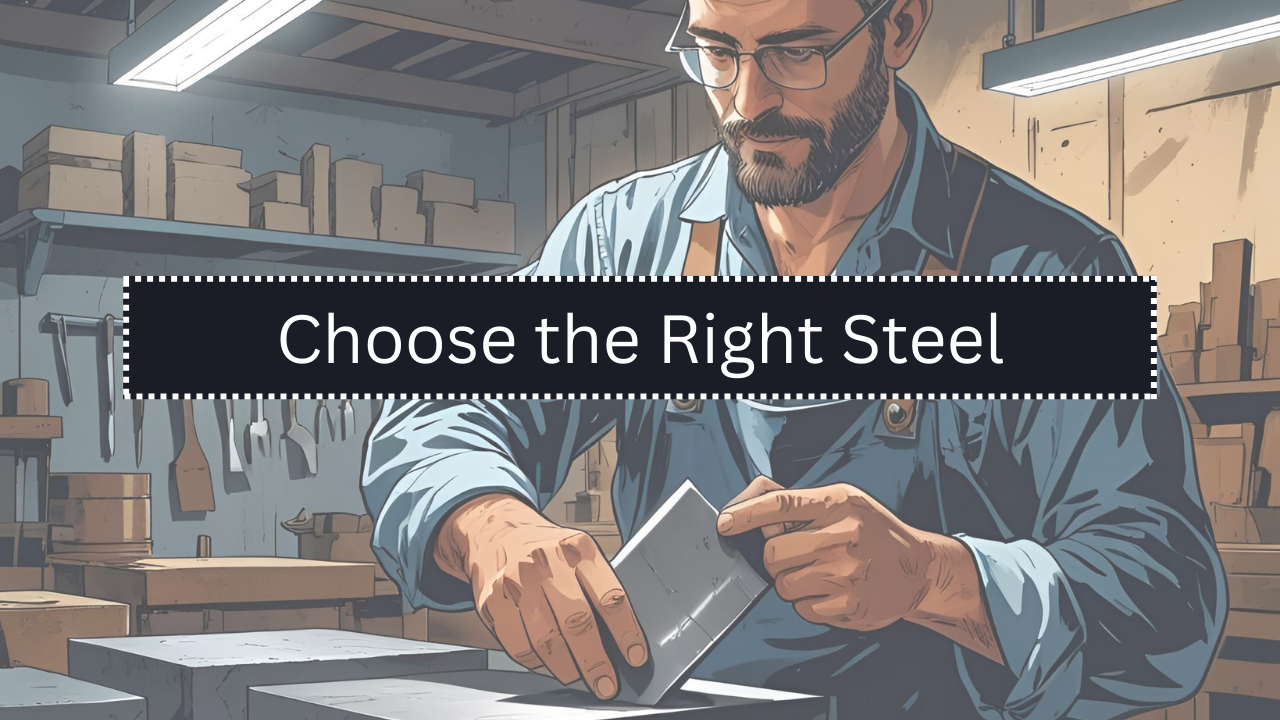Selecting the most suitable steel for your construction, manufacturing, or design project plays a key role in determining strength, cost, safety, and longevity. Steel comes in various types, each with different properties and intended uses. Without understanding these differences, you might end up with material that is too brittle, too soft, too expensive, or otherwise unsuitable for your specific application.
This guide will help you understand the different categories of steel, important selection factors, and how to make an informed choice based on your project’s needs.
Types of Steel and Their Properties
Steel is generally categorized into four main types. Each type contains different alloying elements that alter its strength, ductility, corrosion resistance, and hardness.
| Type of Steel | Main Characteristics | Common Uses |
|---|---|---|
| Carbon Steel | Contains up to 2.1% carbon, low corrosion resistance | Structural beams, auto parts, tools |
| Alloy Steel | Includes elements like nickel, chromium, or manganese | Pipelines, gearboxes, heavy-duty machines |
| Stainless Steel | High chromium content (usually over 10.5%), resists rust | Kitchenware, medical tools, architecture |
| Tool Steel | Extremely hard and heat-resistant, contains tungsten or vanadium | Cutting tools, molds, dies |
Key Factors in Choosing the Right Steel
Before you settle on a steel type, consider these vital factors. Your decision should be guided by the project’s goals, environment, and performance expectations.
1. Mechanical Properties
You should assess the steel’s mechanical attributes, which include:
- Tensile Strength: Ability to resist breaking under tension.
- Yield Strength: The point at which steel begins to deform permanently.
- Hardness: Resistance to surface indentation or wear.
- Ductility: Steel’s ability to stretch without breaking.
| Mechanical Property | Ideal For | Steel Type Suggestion |
|---|---|---|
| High tensile strength | Bridges, skyscrapers | Carbon or alloy steel |
| High ductility | Structural frames, earthquake zones | Mild carbon steel |
| High hardness | Industrial cutting tools | Tool steel |
| Corrosion resistance | Marine or outdoor applications | Stainless steel |
2. Environmental Conditions
The surrounding environment greatly affects the choice of steel. Exposure to moisture, heat, chemicals, and saltwater can degrade some types of steel quickly.
| Environment | Recommended Steel Type | Why |
|---|---|---|
| Coastal or marine areas | Stainless steel | Excellent rust and salt resistance |
| High-temperature zones | Alloy steel | Withstands thermal expansion and high stress |
| Chemical exposure | Stainless or alloy steel | Resistant to corrosion from acids or bases |
| Indoor dry environment | Carbon steel | Economical and sufficient in low-risk areas |
3. Fabrication Requirements
Not all steel types respond the same way to welding, machining, bending, or cutting. The ease or difficulty of fabrication can impact cost and efficiency.
| Fabrication Method | Best Steel Choice | Reason |
|---|---|---|
| Welding | Low carbon or stainless steel | These allow cleaner welds with less distortion |
| Machining | Tool steel or alloy steel | Can withstand precise cutting and wear |
| Bending/forming | Mild carbon steel | Offers high ductility without cracking |
| Laser/plasma cutting | Stainless steel | Clean cuts with minimal oxidation |
4. Cost and Budget Constraints
Cost is always a determining factor. While you might want the strongest or most durable steel, your budget may lead you to explore alternatives.
| Steel Type | Average Cost (per kg) | Cost Efficiency Use Case |
|---|---|---|
| Carbon Steel | Low | General construction where rust isn’t a concern |
| Stainless Steel | Medium to High | Long-term use in corrosive environments |
| Alloy Steel | Medium | Specialized applications with high stress |
| Tool Steel | High | Industrial settings requiring precision tools |
Applications and Suitable Steel Grades
Many steel grades exist within each type. Below is a table showing some common applications and the corresponding best-suited steel grades.
| Application | Recommended Steel Grade | Reason |
|---|---|---|
| Bridges | ASTM A572 | High strength, weldable, weather-resistant |
| Kitchen Equipment | AISI 304 Stainless | Corrosion-resistant and hygienic |
| Gears and Bearings | SAE 52100 (Alloy Steel) | High hardness and fatigue resistance |
| Auto Body Panels | AISI 1010 (Carbon Steel) | Easy to form and affordable |
| High-end Tools | AISI D2 (Tool Steel) | Extreme wear resistance and hardness |
Steel Finishes and Coatings
Depending on the aesthetic or protection requirement, you might also need to consider steel finishes and surface treatments:
- Galvanized Steel: Coated with a layer of zinc for rust protection.
- Powder Coating: Adds a protective and decorative layer.
- Pickled and Oiled: Treated to remove scale and prevent corrosion during transport.
| Finish/Coating | Best For | Common in |
|---|---|---|
| Galvanizing | Outdoor structures | Roofing sheets, fences |
| Polished Stainless | Decorative and hygienic applications | Hospitals, kitchens |
| Black Oxide | Minimal corrosion, aesthetic finish | Tools, fasteners |
| Powder Coating | Durable, attractive surface | Furniture, appliances |
Questions to Ask Before Final Selection
Here are some important questions to help narrow your choice:
- Will the steel be exposed to water, salt, or chemicals?
- Does the project require frequent welding or shaping?
- Is appearance important (e.g., brushed, shiny finish)?
- How long should the structure last without major maintenance?
- What is the maximum budget for materials?
Expert Consultation and Standards
Relying solely on internet research or general knowledge might not be enough for complex projects. You should always:
- Refer to standards such as ASTM, AISI, or ISO to match the right steel grade to its intended use.
- Consult with an engineer or metallurgist if unsure about the right steel for high-load, high-risk, or large-scale work.
The Way Forward
Proper steel selection is crucial for the success and durability of your project. Each steel type brings different strengths and weaknesses depending on environmental conditions, fabrication needs, budget, and performance expectations. By analyzing key factors—like mechanical properties, cost, and intended use—you can choose the steel that perfectly aligns with your project goals.
Whether you are designing a bridge, crafting tools, or building a storage shed, the right steel will enhance performance, save costs in the long run, and ensure structural integrity.

